Armenia – 2015

Fellow travellers
The question has been asked why a Mediterranean society would choose to visit Armenia but I can perhaps summarise it in this way. Armenia is a country of temperature extremes with bitter cold winters with most of the rain or snow fall and searing hot dry summers, not unlike many areas especially at altitude surrounding the Mediterranean. Many of the plants we saw had close relatives around the Mediterranean and some were native to the Mediterranean as well as Armenia.

Dr Anna Asatryan with Dick and Heather Martin
Another major factor was that our sibling organisation, Mediterranean Gardening France, has a member who leads cultural tours to Armenia with Kudu Travel. Katharine Fedden was really keen to help organise a trip and the demand was so great that two had to be planned. The MGF trip was immediately before our MPG trip. Katharine had not visited Armenia at this time of year so it was special to her as well. Her knowledge of the history and culture added a huge amount to the trips.
Our botanical guide Anna Asatryan is a PhD Senior Researcher at the Institute of Botany, National Academy of Sciences of Armenia. Fluent in English, Anna was very knowledgeable about her flora and shared her enthusiasm with us. Her knowledge of locations meant that we found much of what she expected. She also told us much about Armenian culture and their way of life.
Day 1 – Wednesday 3 June
We flew into Yerevan in the evening after what seemed a very long day of travelling. The Tufenkian Historic Yerevan Hotel is placed quite centrally in the capital making our drop off difficult with our luggage.

Charents Arch

Mount Ararat from Charents Arch
Day 2 – Thursday 4 June
Yerevan – Geghard – Garni – Yerevan (city walk/city tour)
Our first stop was a short distance east of Yerevan at the Charents Arch built in 1957 where we should have seen a magnificent view of Mount Ararat but it was obscured by the humidity. Built on a small hill the arch had an array of plants both familiar and unfamiliar. Rosa canina (the dog rose) common throughout Europe including Britain was to be a familiar shrub throughout our whole visit. Thymus cochianus subsp. transcaucasicus (a wild thyme), Euphorbia seguieriana of particular interest to me as I am working on the genus. Eremostachys laciniata with a single specimen in full flower, a striking white labiate which we were to see more of from the coach but not in flower where we stopped again. The site was flanked by a small plantation of trees which harboured at least a nightingale, a cuckoo and a hoopoe.

Gundelia tournefortii
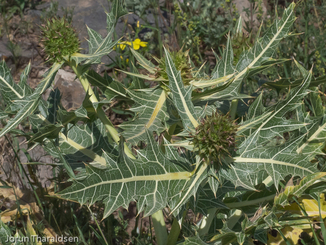
Gundelia tournefortii
Slightly further southeast near Hatsavan we stopped to see Gundelia tournefortii which grew in quantity on a south-facing slope. I saw this same species in the Golan Heights a few years ago, a strange annual composite with a cone-like inflorescence and incredibly prickly leaves and bracts. Anna explained that on maturing and dying the plant curls up into a ball and breaks free acting as a tumble-weed to disperse its seed. There was a subtle range of colouring in the foliage and the flower heads though I failed to find any of the few heads which were in full flower. Glaucium corniculatum (horned poppy) was surprisingly abundant here whereas my experience of the same species on Crete was that it only occurred at low altitudes in very limited habitats near the coast. Here it was growing at over 1500m. A bright yellow flax, Linum nodiflorum was plentiful and a very delicate but elegant Myosotis sp. with a tall panicle of tiny blue flowers. At the top of the slope was an abandoned plantation of Pistacia vera (cashew nut) apparently planted in the Soviet era. Another familiar plant here was Salvia viridis looking like the typical plants I have seen over the years on Crete with virtually no terminal bracts for which this annual species is often grown in gardens.
We drove on only to stop a short distance away to photograph a bold patch of Delphinium orientalis otherwise known as Consolida orientalis, the oriental larkspur.

Linum nodiflorum

Consolida orientalis

Consolida orientalis
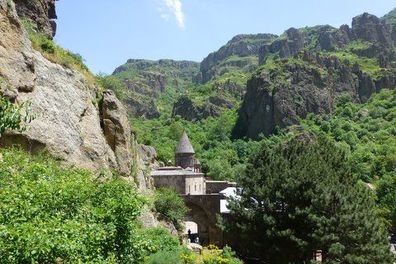
Geghard Monastery
Moving on to a lovely green valley to the south of Geghard where most of us visited the Geghard Monastery. Two of us went off looking for plants. Prangos ferulacea was in full flower and was to prove a common umbellifer with bright yellow flowers and fine feathery foliage. Nepeta racemosa (syn. N. mussinii) only occurred here on a seasonally wet bank by the road. A common garden plant in the UK along with its many cultivars and its hybrid N. x faassenii crossed with N. nepetella. Then our first glimpse of the amazing scarlet poppy, Papaver orientalis, which was just in flower, buzzing with hectic beetles looking and behaving quite like bees. Time running out, Anna drew our attention to a rock face where a compact blue flowered Campanula armena flowered out of our reach.

Geghard Monastery

Nepeta racemosa

Papaver orentalis with bumblebee scarab beetles

Campanula armena
Lunchtime and the coach parked in the centre of Garni from where we took a short walk along a road lined with manure cut into blocks and drying for use as winter fuel. We entered a private house and walked through to the back where there was a colourful garden of bright annuals and a long table laid out for our meal. There was a range of fresh salad leaves, a cabbage salad with sweetcorn and dill, cooked dock leaves looking like horta in Greece, which were particularly tasty and not at all bitter which surprised me and fried aubergines. The accompanying bread was a very thin, freshly made flat bread.

Private garden, Garni

God Mihr temple

Lunchtime
From the garden we could see across to the God Mihr temple positioned on a prominent ridge jutting out into the valley. We thanked our hosts and moved on to the temple for our last visit of the day.
The position of the temple would have been part of a defendable fortress surrounded by steep sides apart from the entrance from the modern town. Built over 2,000 years ago it is the most significant relic of pre-Christian Armenia. It was destroyed by an earthquake in 1679 and remained as ruins until 1969 when reconstruction started. This was completed in 1975. The other interesting feature here was the informal paving composed of polygonal blocks of basalt formed in the same way as those at the Giant’s Causeway in Northern Ireland. This distinct rock formation was clearly visible in the valley below and the scree formed by it would make harvesting the blocks a relatively easy task.
Back in Yerevan a guided tour was organised and we were dropped off at the Cascade Monument, a dramatic hillside of terraces, steps and water features, with formal gardens and fountains in front and a collection of modern art sculptures many in bronze. The huge stone statue of Alexander Tamanian by Artakes Hovsepyan dominates the end of the gardens. Tamanian created the layout for the modern city of Yerevan in the 1920s.
Day 3 – Friday 5 June
Yerevan – Jajur Pass – Vanadzor – Fioletovo – Dilijan
Heading north from Yerevan we made a stop for a view of the Aragatz mountain range across a meadow of Ranunculus sp. and big blue skies. Tripleurospermum transcaucasicum, an annual daisy looking superficially like our oxeye daisies in the UK was scattered through. Anna found a double form which formed a small colony. Not actually a true double flower but with all of the florets as ray florets.
Heading further north just beyond Tsilkar we dropped down through the Spitak Pass into a valley with rich meadows on the north-facing slope. This was very rich and with many floral elements in full flower. Nepeta racemosa was flowering right by the coach. A haze of soft blue were the flowers of Veronica gentianoides punctuated with more scattered colonies of other flowers. Echium rubrum (syn. E. russicum), Lathyrus cyaneus a lavender blue sweet pea, Nepeta betonicifolia, more upright and denser flowered than N. racemosa. Polygala anatolica mostly blues in various shades but also pinks. Pedicularis sibthorpii with soft lemon flowers and feathery leaves. Centaurea cheiranthifolia, a large cream-coloured cornflower. Myosotis arvensis with typical pale blue forget-me-not flowers. Iris furcata, a short, purple-flowered bearded iris with no discernible variation in flower colour. A wonderful site where I could have happily stayed twice as long as there were so many more plants I didn’t see that Anna later listed.

Tripleurospermum transcaucasicum

Echium russicum

Polygala anatolica

Pedicularis sibthorpii

Veronica gentianoides

Centaurea cheiranthifolia
Heading northwest our next stop was to have a picnic lunch at Jajur Pass. Many chose to eat in the shade of the native pine, Pinus sylvestris subsp. kochiana with the typical red bark on the younger branches. In front of us in the open was a range of flowering plants amongst the grasses. The low growing Androsace villosa with white primrose-like flowers and a yellow eye which turns red after pollination; Astragalus fragrans, a sprawling cream flowered legume; Zosima orientalis an umbellifer with bold yellow heads, very attractive but with a disgusting smell; Scutellaria orientalis, a mat of bright lemon beautiful flowers. We were to see this latter plant in several locations but, the plant at this site was quoted as being rare elsewhere. Asphodeline taurica, a small grey candle of bracts with white flowers on top of a tuft of grass like leaves. It didn’t appear to be common even here.
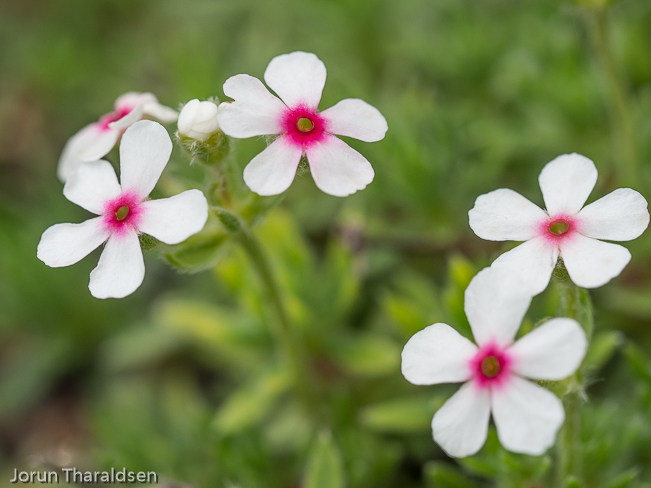
Androsace villosa

Scutellaria orientalis

Picnic lunch

Asphodelne taurica
We walked round into the main valley over the stream filled with large herbaceous plants. Rumex orientalis in full flower, brown and probably not exciting to many people. Sambucus ebulis, still only in leaf, and leaves of an Heracleum sp.. The drier east-facing slope was obviously covered in interesting plants even from a distance. Pink mounds proved to be Onobrychis cornuta, a spiny legume. Spiraea hypericifolia formed quite a stand and was in full flower, around 1.5m high. The white flowered Daphne transcaucasicus grew close to the ground only about 20cm high but wider, spreading quite tightly to the ground. Campanula aucheri, again in perfect flower. A tuft of upward-facing flowers of quite a good blue colour with a hint of mauve. On the other west-facing slope there were other plants but running out of time I rushed to catch a few extra species. Pyrethrum coccineum, a soft pink daisy quite familiar in UK gardens, I only glimpsed a couple of plants. Verbascum phoeniceum in a colour hard to describe. The buds looking almost black but opening to a bronzed blushed yellow. Really attractive and one we would see in several places and from our speeding coach too.
As we left this site the heavens opened for about the only time in our trip. For those of us that weren’t asleep we passed what seems like endless slopes of the black iris, Iris paradoxa, with the promise from Katharine that we would see more later.

Onobrychis cornuta
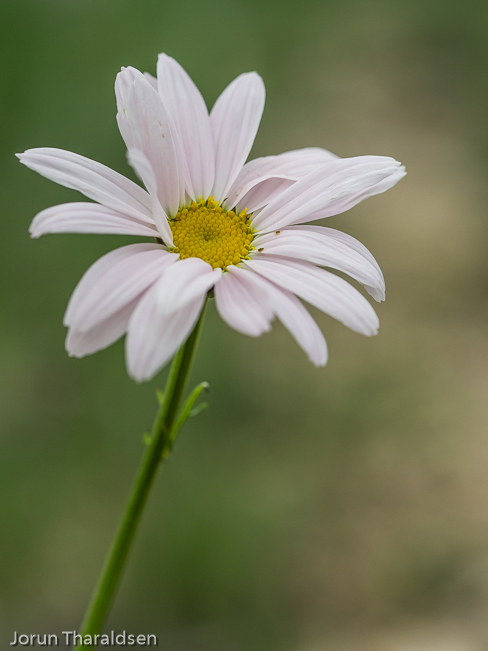
Pyrethrum coccineum

Iris paradoxa

Campanula aucheri

Verbascum phoenicium
Heading east towards Lake Sevan we stopped between Shahumyan and Lermontov in the valley at a wet water meadow. A Dactylorhiza sp. was fairly common here. Patches of Lychnis flos-cuculi (ragged robin) were also quite abundant but according to Anna this was the only known location for it in Armenia. I have seen it in central Italy in damp woodlands and it is quite common in damp habitats in the UK. The dull brown Geum rivale with its nodding flowers was also abundant here. The bank opposite the stream on quite a steep north-facing slope was covered in Anemone fasciculata.
Continuing east along the valley we reached the Dilijan Resort Hotel, a Soviet monolith of a building just west of the main town built on a hillside and fenced in with security on the gate. Here we stayed the night

Dactylorhiza urvilleana
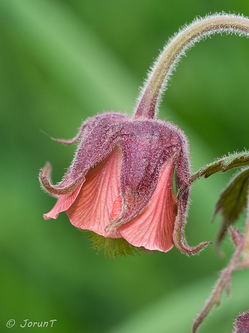
Geum rivale

Anemone narcissiflora subsp. fasciculata

Fording the Aghstev river
Day 4 – Saturday 6 June
Dilijan –- Sevan (the gorge of lilies) –- Semyonovka Pass – Dilijan
Leaving Dilijan we headed south through dense rich forests suddenly to disappear into a tunnel. Once we emerged the habitat was totally different with open meadows once again. We stopped beside a river where two vehicles were waiting to ford us across. We were dropped on the other side with strict instructions from Katharine to walk up the valley first and botanise on the way down. Not an easy request to follow. When the valley evened out to reveal an amphitheatre of meadow we were allowed to botanise.
Needless to say I didn’t venture more than this point as there was far too much to see. Lilium armenum which was here as promised was perhaps three weeks off flowering. At the brow of a slope just up from the track was a nice colony of Iris furcata in the same purple colour as before.
A Dactylorhiza sp. with spotted or un-spotted leaves was quite common. Geranium ibericum with magenta flowers and darker veins was just starting to flower. Anemone fasciculata was abundant on the opposite slope with a few pink forms. Primula veris (cowslip) were mostly finished but a few had lingering flowers. Pulsatilla albana subsp. armena was in the same condition with most flower heads already in seed and quite tall. A lone plant had a perfect flower still. Quickly running out of time here I had to hurry back to the river because there were some lovely clumps of Euphorbia oblongifolia with its distinct bronze flushed bracts. I was really pleased to see this in full flower and get some pictures too. A species of woad, Isatis reticulata formed a large patch with deep yellow flowers. Whilst queuing for our lift back across the river I took some last pictures of Salix caucasicus growing in the bank right by the water presumably suckering to form a dense, all male colony.

Pulsatilla albana subsp. armena

Alfresco picnic

Pink Anemone fasciculata

Local children picking Anemones
A short drive north took us to our picnic site where we had lunch alfresco: time saving and very pleasant with such good weather. From where we sat we could see the nearby town of Semyonovka. This site seemed to be less rich in terms of plants that were in flower. Higher up the slope was dominated by Anemone fasciculata in massive drifts which made the surrounding hills appear to be covered in a light snow fall. Children from the village came to pick the anemones to take home. The girls were concentrating on picking only the pink forms. Fortunately we had done our photography before their work took place as they were very thorough in their task. The boys only picked the common white form. Anna called us over to see an unusual variant, a green-flowered plant, the only one, really striking. There was a single lingering flower on a clump of Trollius patulus. The common, lemon coloured Pedicularis condensata was in perfect flower. Also here was Pedicularis wilhemsiana which elsewhere was completely over, a dull cream with a purple blush. Then a third species I hadn’t noticed before, Pedicularis armena. Another soft lemon one but much smaller than P. condensata.
Another night in Dilijan.
Day 5 – Sunday 7 June
Dilijan –– Artanish peninsula – Tsapatagh
Travelling back towards Lake Sevan we stopped to collect provisions where we could watch traditional bread being made in an open oven set into the floor with the baker doing acrobatic feats to place the dough in the oven

Skill and risk of being a baker

Cooking the bread

John Fielding and Jorun Tharaldsen

Spiraea crenata
On down the north side of the lake where the road almost hugs the shoreline alongside a railway line. Our impromptu first stop was by a rock cutting. We crossed the railway line to get to a small cliff covered in Eremurus spectabilis in full flower. No time for anything else here and we were off again. No sooner had we got settled back on the coach and another stop. Yes it was true, Iris paradoxa would be seen again and on a perfect day too. This was a Carol Klein moment which I didn’t realise until I saw her iris programme recently. She travelled to Turkey to see this species in its two-toned black and white form in a cemetery where she wandered through a drift of Eremurus without even mentioning the Eremurus! Again a scramble across the very quiet railway line and a slope covered in iris and many other lovely plants. I concentrated on the irises and took a few other plants but no doubt missed many more.

Eremurus spectabilis

Field of Papaver commutatum
On to the Artanish Peninsula where we changed to smaller vehicles and soon made a brief stop by a field of poppies which I guessed to be Papaver commutatum. The peninsula juts out into Lake Sevan and is very rich botanically. Turning in from the coast we headed up a valley through a grassy meadow where we stopped to have our picnic lunch. Everywhere you looked there were different plants. The valley runs west to east upslope. On the south-facing side was a thinner coverage of plants with several Juniperus sps. I didn’t cross the small seasonal water course to the other slope as there was so much just in this one area. In the water course was a thicket of shrubs dominated by Berberis iberica, Viburnum lantana and Spiraea crenata.
Here is a plant list including what I saw and those that Anna later listed for us.
Adonis wolgensis
Ajuga chia
Androsace villosa
Astragalus calycinus
Astragalus cornutus
Astragalus gjoktchaicus
Astrodaucus orientalis
Berberis iberica
Bungea trifida
Campanula sibirica
Centaurea rhizantha
Cerinthe minor
Convolvulus lineatus
Cotoneaster integerrima
Cynoglossum orientale
Daphne glomerata
Diphelypaea tournefortii
Euphorbia sequierana
Fraharia vesca
Fumana procumbens
Galium verum
Geranium bulbosum
Hedysarum elegans
Helianthemum nummularium
Hypericum hyssopifolium
Inula aspera
Juniperus depressa
Juniperus polycarpos
Juniperus sabina
Juniperus oblonga
Jurinea squarrosa
Lappula squarrosa
Linum hypericifolium
Linum nervosum
Linum tenuifolium
Lonicera iberica
Melampyrum chlorostachyum
Minuartia lineata
Myosotis arvensis
Onobrychis cornuta
Onobrychis mischauxii
Oxytropis pilosa
Phlomis tuberosa
Polygala anatolica
Psephellus dealbatus
Psephellus somcheticus
Rosa spinossisima
Scutellaria orientale
S.hypericifolia
Sideritis montana
Silene chlorifolia
Spiraea crenata
Stachys lavandulifolia
Teucrium orientale
Thalictrum foetidum
Thymus transcaucasicus
Viburnum lantana
Ziziphora rigida

Centaurea depressa
Astragalus sps. including a purple-flowered lax shrubby species. The wind made photography really quite difficult now.
Another move further down the east side of the peninsula brought us to a coastal habitat. Much of the habitat was a fine scree or very stony. Very rich but sadly little time left to spend here. A large magenta Centaurea sp. stood out with bold flower heads. Prangos ferulaceum was scattered up the slope at the back of the site.
Other plants included Asparagus sp., Sedum stevenianum, Securigera dubia, a lovely pink-flowered legume. Onosma microcarpa, and Pyrethrum parthenifolium, a white daisy which was probably an annual.
Moving on further down the lake to the rather rustic Tsapatagh Hotel for dinner and an overnight stay.

Pulsatilla seed head

Field of Centaurea

Roemeria hybrida
Day 6 – Monday 8 June
Tsapatagh – Selim Pass – Zorats Karer – Goris
The night before we had walked to our meal in a different building to the hotel; breakfast followed the same pattern. In the surrounding mostly man-made habitats there was quite a rich flora. We were given a choice of a rougher trip continuing down the lake side or the comfy coach to take some of us all the way back and round the lake on the good road. Most of us plumped for the rough ride. With some time to spare before we departed I was able to botanise and photograph. A lovely clump of Papaver orientale was in perfect flower. There was a drift of the intense blue Symphytum asperum. An unknown (to me) bearded iris with a soft lavender blush probably long cultivated. Then back to the hotel so as not to be late for the coach. Still not arrived yet so I carried on photographing in front of the hotel. Consolida orientalis again so another portrait, hopefully better than before. The I realised that the small river just a few meters further had some lovely plants growing in its river bed and of particular note, Papaver fujax was in full flower. A brick red colour and very delicate.
The coach and jeeps arrived and we were off. Much of the plain by the lake was really quite bleak with rolling fields and not a tree in sight. We stopped at a wonderful sheet of Centaurea sp. which was a blue annual similar to C. cyanea which we are used to in the UK but this was much more branched. Anna also found us a choice little poppy, Roemeria hybrida, a tiny purple flower hard to see under the masses of Centaurea.
With a further short stop to be bitten by mosquitoes or midges by the river mouth we then met up with the rest in our main coach.
Heading south, past the village of Nshkhark we made a brief stop overlooking the damp meadows. Primula auriculata was still pretty much in full flower with pink heads on tall stems. Geum rivale with its nodding brown heads and Dactylorhiza salina with plain green leaves. Just before we rushed off I noticed a huge clump of Caltha polypetala still with a few flowers out up against a bank of manmade rubble.
On further south to the medieval Orbelyan Caravanserai looking for all the world like a giant farm building until you get closer and notice the carvings above the door and it is built entirely of high quality cut basalt stone. In wonderful condition this was effectively one of the “hotels” on the silk road.

Primula auriculata

Orbelyan Caravanserai

Iris acutiloba subsp. lineata

Carvings above the door

Melvyn Jope amongst Gladiolus atropurpureus

Gladiolus atroviolaceus
Another lovely lunch at an establishment by a tree-lined river and we drove on further south, topping at a field of Gladiolus atropurpureus, the only time we saw this species. It was very windy and difficult in the time allowed to get good sharp photographs. On again to the ancient megalithic monument Zorats Karer standing stones from around the bronze or iron age. Added to this dramatic monument Iris acutiloba subsp. lineata was also in full flower; again very strong winds made even this short iris difficult to photograph. After this last stop of the day we headed on to Goris to our next hotel.

The mountain village of Vorotan

Vegetable plots below the funicular car

Vorotan river gorge
Day 7 – Tuesday 9 June
Goris –Tatev Monastery – Bardzravan village – Goris
To the south of Goris we headed for the Vorotan gorge to take the funicular from above Halidzor across to Tatev. Unlike most funiculars this one travels almost horizontally across the gorge. Looking down on the town of Vorotan you could clearly see that horticulture was predominantly for growing food. Perfect vegetable plots were in every back garden. Rising over a ridge before traversing the gorge I could clearly see a patch of Dictamnus caucasicus in full flower, so close and yet so inaccessible.
In Tatev we were greeted by a fleet of cars which took us up the dirt road to the higher pastures. On arrival as we went off to photographically graze the wild flowers one of the drivers started collecting wild thyme. Anna knew this site was particularly special for orchids and we were not disappointed. First a scattering of Gymnadenia conopsidea, sweet scented orchid, then on to another patch with perhaps 20 or so Platanthera chlorantha, butterfly orchid. Both these are British native species. A lone specimen of Anacamptis coriophora, the bug orchid. Several Steveniella satyrioides, well past their best but still quite recognisable, and a lone, very tall specimen of Ophrys caucasica with the last flower still just looking quite good. Also on this south-facing slope were drifts of Genista transcaucasica, a short broom with rich yellow flowers. Geranium ibericum was in full flower with typical bright magenta blooms.
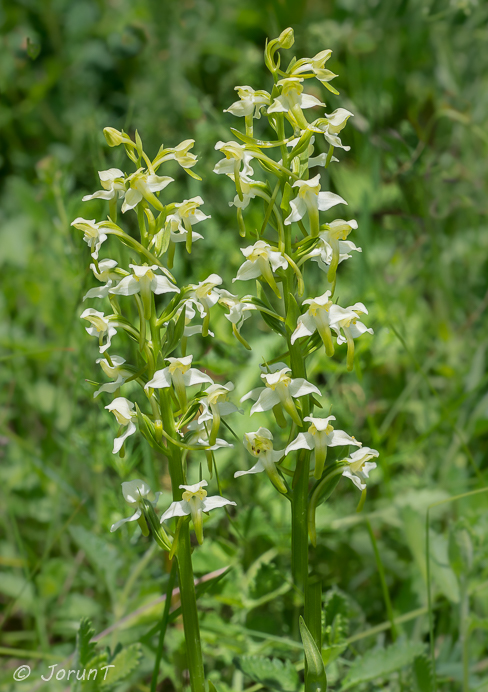
Plantanthera chlorantha

Gymnadenia conopsea

Anacamptis coriophora

Genista transcaucasica

Steveniella satyrioides
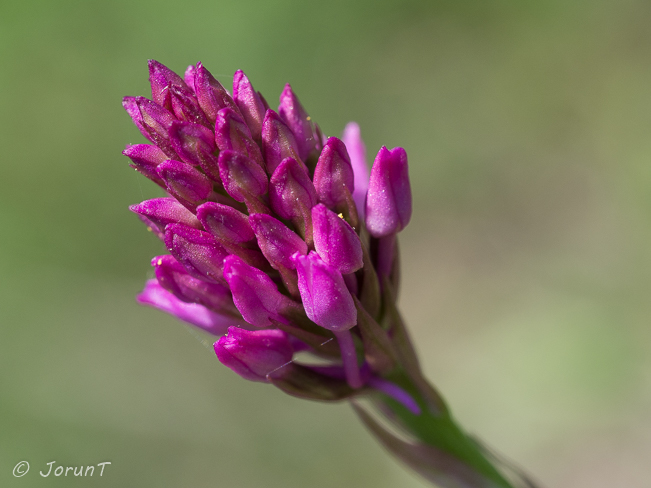
Anacamptis pyramidalis
Just over the ridge on the northern slope Iris caucasica was fully in seed growing in an area with thin vegetation. On down the slope through a meadow lush with white daisies, perhaps Leucanthemum vulgare and buttercups, Ranunculus sp. and dotted with gems such as Gentiana cruciata and Orchis punctulata just finishing. Time for a group photo on a grassy knoll which was on the edge of the gorge, a vertical drop beyond. Then a short walk back to the road past Rosa canina in perfect flower and another lone orchid, Anacamptis pyramidalis, the pyramidal orchid, common through much of Europe including the Mediterranean and Britain.

Tatev Monastery
Back to Tatev for lunch where shade was much appreciated; it was again a hot day. After lunch most went to the Monastery and I walked back down the track to see a few extra plants then we went back to Goris via the funicular and our coach with a stop above the town to take pictures. An attractive place with tree-lined streets backed by rock outcrops with medieval cave-dwellings.
Day 8 – Wednesday 10 June
Goris – Noravank –Yerevan
After quite a bit of driving back towards Yerevan we stopped in a valley to the east of Vayk. There were many plants we had not seen elsewhere: Dianthus orientalis was in full flower on the vertical cliffs. There were sedums with big succulent leaves (now split off into a new genus, Telephium). A Campanula sp. now past its best was still showing quite a few flowers, again, like the Dianthus a chasmophite. Alcea rugosa was perfect with soft lemon-coloured flowers but it too only grew high up on the cliff face. By the road was a single clump of an Echinops sp. not actually in flower but with typical spherical heads.
We walked far enough up this side valley to see a hillside covered in a special Pyrus sp. but ran out of time to investigate further.

Dianthus orientalis
On to the Noravank Monastery on the slope of a sheltered valley. Needless to say I did not visit the monastery but continued botanising down the slope. There was a rich array of grasses among which Anna identified Hordeum bulbosum, a wild relative of barley, and Stipa arabica which was very ornamental with its silvery long plumes waving in the wind making it difficult to photograph. Capparis spinosa (the caper, according to Anna) was at last within camera range. I saw it as we drove out from Yerevan but only from the coach. I am quite surprised if this is the same species as we see in Greece as though it is growing on dry banks it must be very hardy to cope with Armenian winter temperatures. Pistacia mutica, a species of wild pistachio with large leaves and substantial panicles of fruit and another fruit tree (or actually a shrub) Amygdalus sp., a wild almond. Salvia sclarea (the clary sage) was looking for all the world like a British garden escapee, typical of this species which I have also seen on mainland Greece.

Salvia sclarea

Capparis spinosa

Bridge over the stream
Travelling on the valley became more of a gorge and we stopped for a brief photo. The near vertical cliffs were dotted with chasmophytes, but we could only wonder as to what was up there.
Heading on towards Mount Ararat which was still obscured by the haze we stopped just north of Tigranashen, the habitat seemed particularly dry and steppe-like. We were given 15 minutes but I could have happily spent half a day here as it was so rich. Onobrychis sp. the same as we saw by Lake Sevan with Iris paradoxa was particularly beautifully veined. Salvia hydrangea in a rich deep pink. A Paronychia sp. almost camouflaged against the stones and soil with its silvery bracts. Anna listed many others that I neither saw or photographed. I was particularly sad that she said Euphorbia marcshalliana would be seen here but I failed to see it, only then to be told by Melvyn Jope that he found it higher up.

Salvia hydrangea

Salvia hydrangea
Day 9 – Thursday 11 June
Yerevan –– Aragatz – Yerevan
Our final day and we headed to the northwest of Yerevan to the Aragats Mountain (4095m), an extinct volcanic massif and the highest point in modern Armenia.
To acclimatise to the altitude (which didn’t seem to be a problem to any of us) we made a few short stops en route. First stop was a roadside bank dominated by Echium russicum (syn. E. rubrum) and Rhinanthus sp. (rattle). Another plant of note was Cerinthe minor with its grey foliage and small (hence the minor) yellow flowers. Finishing with Arenaria dianthoides a tall species with tight clusters of pristine white flowers. Another stop for a bank of Gladiolus caucasicus. Very brief and off again.

Cerinthe minor

Gladiolus caucasicus
The next stop was at 2460m and the flora started to look quite different. The turf was shorter and immediately on stepping off the coach I photographed a patch of Ornithogalum sp. and Nepeta racemosa (syn. N. mussinii) just starting to flower. A quite prostrate Veronica sp. and a Geranium sp. with almost fluorescent violet blue flowers in the bright sunshine. Ajuga sp. with sombre purple blushed bracts but bright mauve flowers. A brilliant white Cerastium sp. These were all in one spot right by the coach! A few metres more, the woody plants were distinctly prostrate no doubt due to the winter deep snow cover as well as genetics.
Juniperus depressa was quite common often hugging the rocks and a Daphne sp. whose bright white petal-less flowers have only a showy calyx. (This is true of all Daphne.)
Then on to the top, well not actually the top but up to the Cosmic Rays Research Station by Kara Lake. This was as high as we went at 3200m. Even in the brilliant sunshine the place had a somewhat desolate feel to it with the abandoned station and the concrete barrier dam to the lake. There were still plenty of patches of melting snow with running water and puddles along the road, but I didn’t notice any plants here.

Pulsatilla albana
Then, after a short drive back down the way we had come up we stopped and right by the road was an area incredibly rich with yummy plants. These were snowmelt plants which sit ready to burst into flower as soon as the snow has gone. Merendera raddeana and Colchicum biflorum which are closely related corms. Gagea glacialis and Muscari sosnowskyi both bulbs. Jurinea moschus here only in bud, allied to thistles or corn flowers (Asteraceae). But, here, the pasque flower that we saw either just hanging on in flower previously or mostly in seed was perfect. Pulsatilla albana looking like a true alpine with short flowering stems. Though very subtle the colours were quite variable with one plant looking almost white. Chamaesciadum acaule, Apiaceae, a member of the carrot family with its umbel flower head flat to the ground. Sibbaldia parviflora quite like a potentilla, again flat to the ground. Both of these a soft yellow.

Gagea glacialis

Merendera raddeana

Colchicum biflorum
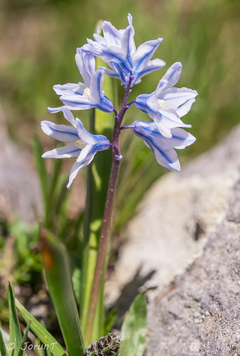
Puschkinia scilloides

Scilla armena

Muscari sosnowskyi
No sooner were we on the coach and we were out again. Just a bit lower but a fabulous site! No pasque flowers here but Anna quickly found one of the special endemics in full flower, Ranunculus aragazi, actually quite a typical looking yellow buttercup about 15cm high but in perfect condition and a lovely clump. Scilla armena, pretty much the same as Scilla sibirica with dark blue pendulous flowers and a pale blue relative Puschkinia (Scilla) scilloides, including a few albino plants. Muscari tenuiflorum appears to be the species I photographed here but Anna said that M. caucasicum and M. sosnowskyi were here as well. I found a Jurinia moschus in flower. An Alyssum sp., a bright yellow crucifer formed small patches and even scarcer Pedicularis armena, a small species with pale cream flowers. The stunning highlight to all of these was the intense blue Gentiana pontica subsp. verna, in perfect flower.
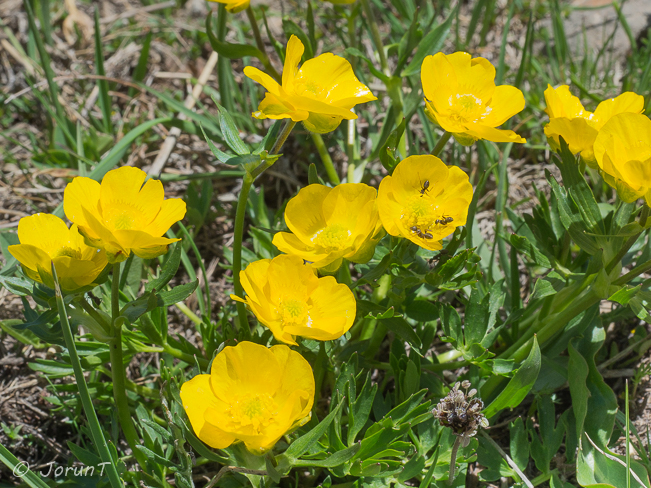
Ranunculus aragazi

Gentiana pontica subsp. verna

Jurinia moschus
We were very strongly warned about wandering through dense herbage as there are poisonous snakes. Fortunately we had no problems with this.
Prangos ferulacea was an abundant umbellifer here with bright yellow heads and of a similar hue and stature an Isatis sp., a woad plant. As we walked around the fortress on the side facing into the valley the scene became almost garden-like and dotted through this garden were clumps of the rare and spectacular Nectaroscordum tripedale, a tall rich pink-flowered onion with gorgeous bell-shaped flowers. Finally we made acouple more stops of which the last was for another field of Gladiolus caucasicus with again some nice patches of Arenaria dianthoides. Then back to Yerevan for our last night in Armenia.

Nectaroscordum tripedale

The furthest south

would particularly like to thank Anna Asatryan, Katharine Fedden (left), Heather Martin and Christine Savage for their contributions to this trip.
Text by: John Fielding
Images by: Brian Constable, John Fielding, Melvyn Jope, Heather Martin, Richard Robinson, Jorun Tharaldsen.

